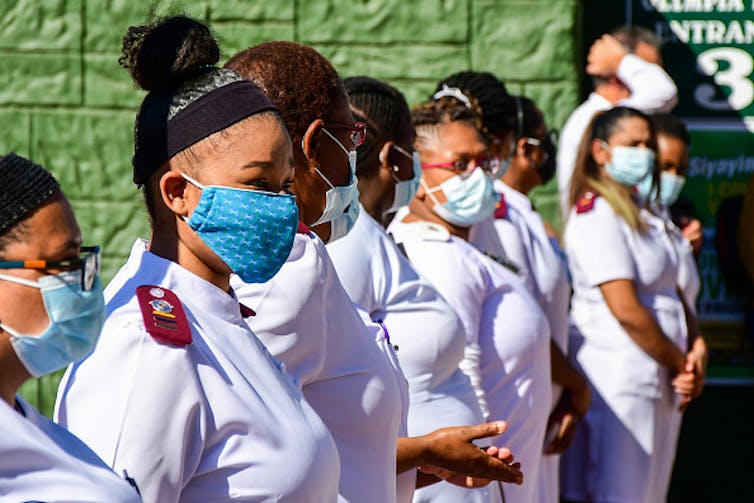Pandemic Underscores Burden Women Carry Doing Paid And Unpaid Reproductive Labour


The Oasis Reporters
August 12, 2020

Photo by Darren Stewart/Gallo Images via Getty Images
Odile Mackett, University of the Witwatersrand
Debates about women’s unpaid reproductive labour have been going on since the first woman received cash for her services. Reproductive labour includes cooking, cleaning, and caring for the elderly, the sick and children.
It’s important to make the distinction between paid and unpaid reproductive labour. Paid reproductive labour is performed in exchange for money or a wage. Unpaid reproductive labour is done for free, and usually for the household in which the individual lives.
This reproductive work has traditionally been undervalued by both formal and informal institutions in societies, whether paid or unpaid.
As paid reproductive workers, women often find themselves in occupations that are highly feminised. These are jobs which consist of a large percentage of female workers, such as work in domestic service, health care or clerical work. This is either because those are the only types of jobs available to them or because their ‘skill set’ is said to be conducive for that type of labour. These types of occupations also tend to be lower paid and more insecure than other occupations.
As unpaid reproductive work, on the other hand, the work of women has gone widely unnoticed and is excluded from things such as the calculation of a country’s gross domestic product (GDP). Even though the calculation of GDP is said to consider goods produced within the home, quantifying the value of goods produced for use within the home is still a challenge for statisticians.
The production of goods and services within the home has typically been carried out by women, as girls and boys are socialised about their respective roles within the household from a young age. As women entered formal paid employment, many thought (as per the prescriptions of traditional economic theory) that the reproductive labour burden would equalise between men and women. But this didn’t happen.
The gap between men and women in paid and unpaid work remains vast, and women who are in paid jobs often still perform these duties in addition to their wage labour. Women are estimated to spend up to five hours a day more on unpaid reproductive labour than men. To cope with these responsibilities, these tasks have increasingly become ‘outsourced’ to people who live outside the household. Examples are employing a domestic worker to clean, employing a nanny to care for children, or ordering take-aways rather than cooking in the home.
Even where these tasks are performed outside the home, women may be left to pay for them or ‘manage’ the employees who perform them.
Women’s extended working days have thus become normalised, despite the adverse effects this has on women’s progression within the labour market and their general well-being.
The COVID-19 pandemic has forced a fresh look at this state of affairs. It has shone a light on the impact that poverty, inequality and unemployment have on people every day. This includes the hardships women face and the burden placed on them to manage responsibilities on a daily basis.
Drivers
Some of the reasons women have been adversely affected by the current pandemic include the fact that health workers and other essential service workers are disproportionately female. In addition, women are more likely to be employed in insecure jobs.
An underestimated problem is the fact that the institutions to which women traditionally outsourced their domestic duties have been closed down to prevent the spread of the coronavirus for extended periods. Domestic workers and nannies have been sent home, and schools, restaurants and fast food outlets have been closed.
As a result, all these services have had to be performed within the household.
This has worsened existing inequalities between men and women. In countries like the UK and the US, women have started spending more time than men on childcare and home schooling, but have also been more likely to lose their jobs as a result of business closures.
In South Africa, more than half of women reported that they were temporarily absent from work during the lockdown. Men have not been as severely affected. Women have also been more likely to lose their jobs than men. The loss was more likely if the individual had lower levels of education or was employed in the informal sector.
In addition, a greater percentage of women compared to men reported living with at least one child, and women also tended to have more children in the household compared to men. This has resulted in more time spent on childcare, whether they remained in employment or not.
This pandemic has thus highlighted how important the work of women is to the ongoing functioning of our society. Women are currently saddled with the ongoing education of the future workforce of the country while schools gradually reopen. They are also more likely to be doing the cooking, cleaning and caring in the home. Or they are managing whoever is being paid to do it instead.
This again highlights the need for governments to take a gendered approach in policy deliberations for relief during and after the pandemic. Numerous recommendations have been made including the provision of basic social protection to informal sector workers – many of whom are women – and ensuring women are adequately represented in discussions related to relief measures.![]()
Odile Mackett, Lecturer, University of the Witwatersrand
This article is republished from The Conversation under a Creative Commons license. Read the original article.












